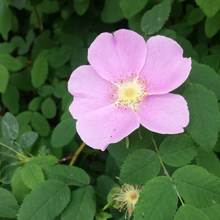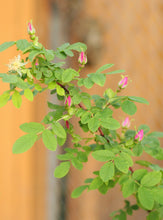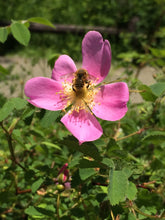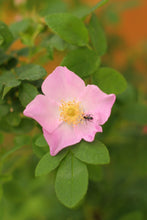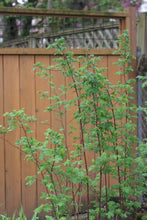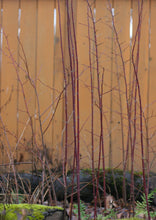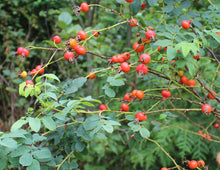
Rosa nutkana
Nootka rose is an upright, thicket-forming, deciduous shrub with unrivaled wildlife value. Large, sweet-scented pink flowers appear at the branch tips in mid-to-late spring. These attractive flowers mature into summer fruits, called hips, that are highly nutritious in tea and eaten by countless species of birds and mammals, especially in the winter months when other foods are scarce.
- Plant type/canopy layer: deciduous, large shrub
- Size at maturity: 4-10' tall, 2-3' wide
- Light requirements: full sun, part sun/part shade
- Moisture requirements: dry to wet soil
- Bloom time: April - August (April - May in the Portland Metro area)
- Growth rate/ease: fast growing, easy to grow
- Wildlife support: leaves/twigs are a food source for squirrels, beavers, porcupines, deer, elk, moose, caribou and bighorn sheep; young shoots are also popular with aphids which in turn provide food for a wide range of predators including ladybugs and songbirds; flowers attract and provide nectar for hummingbirds, adult butterflies and bees and are well-known as “deer candy”; hips provide food to several bird and mammal species including grouse, bluebirds, juncos, grosbeaks, quail, pheasants, and thrushes - plus chipmunks, rabbits, hares, porcupines, coyotes, deer, elk, and bear; seeds are used by birds as a source of grit; the overall plant attracts and supports predatory and other beneficial insects and is a caterpillar host plant and larval food source for several species of native bees and butterflies including mourning cloak butterfly; thickets provide critical shelter and habitat for birds such as pheasants and grouses
- Native habitat/range: locally common in thickets, riparian areas, along forest edges, and on rocky slopes from Alaska to California, and east to the Rocky Mountains. Portland Plant List - yes.
- Special features & uses: bird and wildlife favorite; fragrant flowers; landscape uses include pollinator gardens, raingardens, habitat hedgerows; traditionally used medicinally by many indigenous groups in the Pacific Northwest (including the Bella Coola, Cowichan, Lummi, Nlaka'pamux, and others), an infusion of roots and sprouts can be used as eyewash, decoction of bark can be used in tea to ease labor pains during childbirth and as a hair/body wash, poultice of chewed leaves eases bee stings, decoction of roots can treat sore throats, decoction of branches treats diarrhea and vomiting, poultice of ashes can heal skin swellings; young shoots are edible raw, boiled, dried, made into a jam or tea, and used as a spice, hips can be made into a delicious tea, exceptionally high in vitamins A, C & E; roots can be used to make reef nets, branches for hand brooms, to remove human scent before hunting and are believed by some to bring good luck; dried flower petals make excellent potpourri
Gardening with Nootka Rose: Nootka rose is a gorgeous wildlife magnet that prefers full to partial sun and tolerates most types of soils - including drought and seasonal wetness! That said, it is aggressive and eventually forms large, impenetrable thickets over time. It is valuable for stabilizing banks, especially along streams and is ideal for colonizing large spaces and habitat-friendly hedgerows where space allows.
Photo Credit 1 (flower close-up): © John Brew, some rights reserved (CC-BY-SA)
Photo Credits 2, 4-6 (branch with buds, flower with bug, branches in the garden): Karli Del Biondo, Beetles and Bees
Photo Credit 3 (with bee): "Rosa nutkana" by Jeffrey Lee (he/him/his) is marked with CC0 1.0.
Photo Credit 7 (hips on branches): © 66dodge, some rights reserved (CC-BY)







